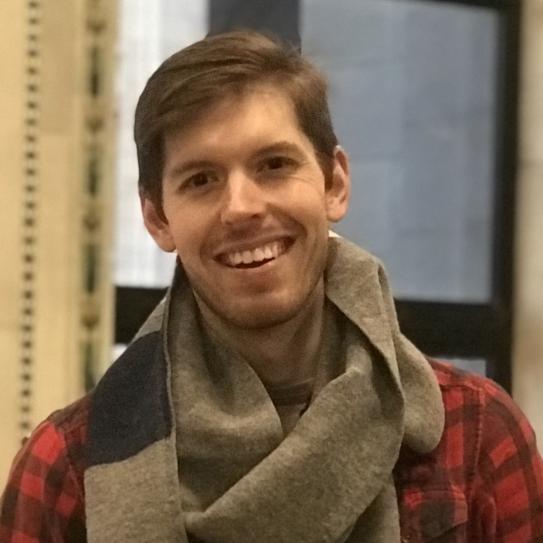Russell Wustenberg

The NYU Tandon Bridge program is aimed at students from a wide variety of nontechnical backgrounds seeking to gain the foundational knowledge that will enable them to embark on challenging STEM-related master’s programs. Because of that, those entering the program have often taken circuitous paths or been through compelling experiences. From the psychology major who had always loved computers but was sidelined by dreams of Olympic pole vaulting to the anthropology student who saw the chance to create online education opportunities in underdeveloped nations, the Bridge has had a succession of interesting participants. But interesting hardly seems to scratch the surface when it comes to describing Russell Wustenberg, who completed the program in 2021 and went on to earn a master’s degree in computer science this year.
Wustenberg grew up in Northfield, Minnesota, on a sheep farm run by his parents as a sideline to their main careers: his father as a toxicologist involved in investigating the safety and biocompatibility of medical devices, and his mother as a press secretary and policy director to such state-level politicians as Governor Jesse Ventura.
Wustenberg had always had a musical bent: his similarly inclined grandfather sang tunes to him as a child, and at 13, he became enamored of opera. After graduating from high school, he attended Minnesota’s Concordia College, which boasted a highly regarded music program and ties to the Fargo-Moorhead Opera Company. That company provided Wustenberg — who earned his bachelor’s degree in vocal performance in 2013 — with his first role, in a production of Verdi's La Traviata. He went on to earn a master’s degree in music from McGill University, in Montreal, Quebec, and by 2019, he had worked on over 60 operatic productions in the United States and Canada.
A turning point came when famed Canadian theater and opera director Peter Hinton reached out to him to work on the premiere of Rufus Wainwright’s 2018 opera Hadrian, based on the life of the Roman emperor. The set included intricate computer-generated projections, sparking Wustenberg’s interest in how such graphics could be employed in storytelling.
A confluence of events allowed him to explore the topic further: the COVID-19 pandemic, which shut down live performances, and the arrival in his inbox of an advertisement for the Bridge program. Eager to make good use of his enforced time away from the opera stage, he quickly registered. “It would be fair to say I leapt before really looking,” Wustenberg recalls. “But I took to the work immediately. In opera, small gestures build upon one another to add up to a greater whole, and I found the same thing to be true in programming. Yes, the Bridge was challenging, but I once worked on a three-hour Czech opera that required almost mathematic untangling, so I knew I could do it.”
In the winter of 2021 Wustenberg completed the program and earned his certificate — a feat that required the equivalent of 400 hours of course work covering such topics as Programming, Object Oriented Design, Discrete Math, Data Structures and Algorithms, Operating Systems, and Computer Networks. With the pandemic then still ongoing, he decided to continue on to a Tandon master’s program.
Thanks to a class in computer vision, he met Institute Professor Guido Gerig, a world-renowned expert in medical imaging. Invited to work with Gerig in the Visualization and Data Analytics (VIDA) Research Center, Wustenberg began to investigate the movement of the eight small carpal bones in the wrist, using 4D magnetic resonance images provided by clinicians from NYU Langone as part of a joint NIH-funded project between NYU Radiology and Tandon’s Department of Computer Science and Engineering.
“You might think that we know all there is to know about the skeletal system but the fact is that we still don’t have a normative model of this area because there have been no large datasets of images to work with until now,” Wustenberg explains of the research that formed the basis for his master’s thesis. “Previous techniques like computed tomography would not have been capable of capturing these high-resolution moving images without exposing patients to high levels of radiation.”
Having an accurate normative model — a picture of the way healthy carpal bones move — will allow doctors to discern when there is a deviation from the norm and lead to better and earlier diagnoses.
"Quantitative analysis of time-series of 3D clinical data represents a challenging topic for computer science and requires development of innovative, novel image analysis methodologies,” Gerig asserts. “In clinical settings, kinematic analysis of joint motion — rather than single image snapshots as is standard practice today — will open new opportunities for diagnosis and therapeutic intervention. Russell presented an outstanding M.S. thesis to push multidisciplinary science forward, and it is a testament to the Bridge program that he was able to go on to conduct this highly valuable research."
“Other master’s students will carry on the work after I graduate,” Wustenberg says. “This is just the beginning.” It’s the beginning, as well, of the next stage of his life, during which Russell hopes to harmonize the many chapters of his past. As “act one,” he recently co-founded a company, Maple Forged, to produce “Grab Your Goat!” a family-friendly, table-top game he developed in which players chase after their escaped goats. Whether it's further work on carpal bone kinematics or re-imagining the aria “La capra e la capretta,” his future is sure to be interesting. "And," he says, "it will be all the richer for having studied here at Tandon."

